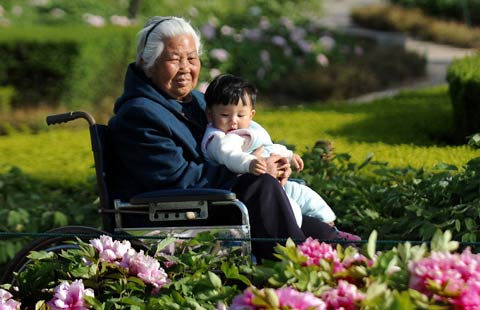Visa extension a milestone between China and US
Updated: 2014-12-05 14:32
By Zheng Xin in Beijing(China Daily USA)
|
|||||||||||
The extension of visa validity from one to 10 years for short-term business and leisure visitors is an important milestone in advancing America's ability to attract international travellers, said Arne Sorenson, president and CEO of Marriott International.
"This reciprocal agreement between China and the United States allows flexibility for the traveller and because of that, makes the US a more attractive destination," said Sorenson, whose hospitality company is headquartered in Bethesda, Maryland. "Frequent travellers will no longer need to re-apply, wait and pay for a new visa annually."
The visa extension will make it much easier for both Chinese and Americans to discover each other's countries and culture, he said.
China has a tremendous outbound travel market, accounting for 20 percent of the growth in overseas visits to the United States since 2008. However, the potential is far beyond that.
According to the White House, Chinese travellers consistently rank the United States as their top desired travel destination, but only slightly more than 1.8 percent of total outbound travellers go to the United States.
Chinese travellers cite ease of visa policies as the second most important factor in deciding where to travel, behind cost.
With the visa extension between the world's two biggest economies in place, Sorenson forecasts Marriot International hotels in the US will see an 18 percent increase in Chinese guests, adding that as many as 7.3 million Chinese are projected to travel to the United States by 2021 for the industry overall.
"That is expected to contribute nearly $85 billion a year to the economy and support 440,000 jobs," he said. "We'll need more waiters, housekeepers, front desk clerks, concierges, more vendors, outside suppliers as well as more cultural and language experts."
Marriott International has more than 4,000 lodging properties located in the United States and more than 70 hotels located throughout China.
For every 35th visitor from overseas one new job in the travel industry is created, Sorenson said, so from a jobs perspective, the surge will be very good news.
"The rate of job growth will have much to do with where these travellers choose to explore. Only about 4 percent of the Chinese outbound travellers landed in the U.S. in 2012, which suggests we can do a better job of welcoming our Chinese friends," he said.
In addition to the optimistic outlook, the agreement might also bring with it new responsibilities for the hospitality part in the United States.
Whether the airports and customs in the United States would be able to handle this flood of visitors and the transit system safely and efficiently serve the tourists in seeing an authentic rodeo in Texas, snapping a picture in front of the Hollywood sign and tasting a true New York slice of pizza is a question worth considering in the country, said Sorenson.
Sorenson compared the flow of Chinese tourists to a river, which "runs pleasantly through fields that rely on it for irrigation and quenches the thirst of people who could always use more water".
However, as the river is about to be "flooded with rain, a sea of rain", it poses a question for the locals whether to "catch that water and contain it or let themselves get overwhelmed".
"That's a pretty good image of what the tourism market faces in the coming years from the Chinese traveller," he said.
During the gathering of travel industry leaders in China for the World Travel and Tourism Council global summit, China's vice-premier said the growth of the Chinese middle class in the coming decade will fuel a surge of 500 million outbound travellers.
"That figure will translate into tremendous opportunity for people to explore experience and see the world and it will also translate into new demand in our industry," he said.
According to the U.S. Commerce Department, last year witnessed 1.8 million Chinese visiting and spending a total of $8.8 billion.
According to a report released by tourism shopping company Global Blue, a shopping tax refund and currency exchange company based in Nyon, Switzerland, Chinese tourists remain the biggest spenders on travels overseas. Their average spending in the first quarter grew 25 percent year-on-year to 846 euros ($1,150) per person, compared with the global average of 502 euros.
The report also shows that Chinese outbound tourism spending accounts for 27 percent of the total global consumption, followed by Russia, Indonesia, the United States and Japan.
Eighty-two percent of Chinese tourists surveyed for the report said they believe shopping is a priority task while traveling, and the average shopping budget per Chinese person reached 10,773 euros.
Dai Bin, head of the China Tourism Academy, said Chinese outbound spending has grown rapidly in recent years and the global destinations should attach significance and tolerance to Chinese outbound tourists.
"The United States is serious about welcoming this economic opportunity," he said.
zhengxin@chinadaily.com.cn
Related Stories
New visa extension will boost US tourism 2014-11-11 12:46
Today's Top News
US, Britain pledge to support Afghanistan
HK visit: A political kabuki
Ukraine unlikely to join NATO in near future
Hotpot chain to raise $129m
2014 likely to be record warmest year
Ukraine's ceasefire talks continue
China marks 1st Constitution Day
Outbound tourists hit record 100m
Hot Topics
Lunar probe , China growth forecasts, Emission rules get tougher, China seen through 'colored lens', International board,
Editor's Picks

|

|

|

|

|

|





